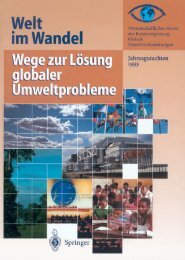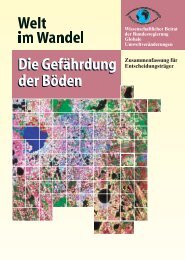World in Transition: Climate Change as a Security Risk - WBGU
World in Transition: Climate Change as a Security Risk - WBGU
World in Transition: Climate Change as a Security Risk - WBGU
You also want an ePaper? Increase the reach of your titles
YUMPU automatically turns print PDFs into web optimized ePapers that Google loves.
constitutional theory and an end <strong>in</strong> itself; it is a political<br />
necessity, enabl<strong>in</strong>g the state to perform the core<br />
functions without which peaceful social relations <strong>in</strong><br />
the complex <strong>in</strong>teraction of our modern societies are<br />
well-nigh impossible.<br />
In the analysis of states, it h<strong>as</strong> proved helpful to<br />
establish differentiated categories b<strong>as</strong>ed on an idealtypical<br />
cont<strong>in</strong>uum of state stability. At the positive<br />
end of the spectrum, there is the fully-function<strong>in</strong>g<br />
modern nation state which meets all three criteria<br />
(e.g. Norway); at the negative end, there is the failed<br />
state which, when me<strong>as</strong>ured aga<strong>in</strong>st legal and formal<br />
criteria, is barely recognizable <strong>as</strong> a state at all (e.g.<br />
Somalia). B<strong>as</strong>ed on Schneckener (2004), four categories<br />
represent<strong>in</strong>g dim<strong>in</strong>ish<strong>in</strong>g quality of state stability<br />
are presented, with dist<strong>in</strong>ctions be<strong>in</strong>g drawn<br />
between consolidated, weak, fragile and failed states<br />
(Box 4.2-1). However, the cl<strong>as</strong>sification of the various<br />
<strong>in</strong>dividual states can only ever be transitory, present<strong>in</strong>g<br />
a snapshot of current conditions and trends,<br />
and it is not always possible to draw a clear dist<strong>in</strong>ction<br />
between weak and fragile states, for example<br />
(Roehder, 2004; Schneckener, 2004).<br />
Numerous examples bear witness to the ‘state fragility’<br />
phenomenon <strong>in</strong> its various facets and forms.<br />
From a regional perspective, sub-Saharan Africa is<br />
particularly strik<strong>in</strong>g; many countries here can be cl<strong>as</strong>sified<br />
<strong>as</strong> weak (Mehler, 2002; Grimm and Kl<strong>in</strong>gebiel,<br />
2007). Indeed, <strong>as</strong> many <strong>as</strong> one-third of them are considered<br />
to be at acute risk of state failure (Roehder,<br />
2004). However, examples of weak states also exist<br />
<strong>in</strong> Asia (e.g. Afghanistan), South-E<strong>as</strong>t Europe (e.g.<br />
the Serbian prov<strong>in</strong>ce of Kosovo) and South America<br />
(e.g. Colombia).<br />
Causes<br />
It should be noted, first and foremost, that there is<br />
still a lack of reliable empirical research about failed/<br />
fail<strong>in</strong>g states, especially <strong>as</strong> regards the causes of state<br />
failure processes. Accord<strong>in</strong>g to one plausible causal<br />
model, state failure is triggered when the state first<br />
Box 4.2-2<br />
State fragility: Destabiliz<strong>in</strong>g factors<br />
Structural factors: Conditions which relate to natural<br />
features of a country, e.g. m<strong>in</strong>erals or climate, and longterm<br />
political, cultural and socio-economic characteristics,<br />
e.g. ethnic diversity, demographic development,<br />
‘colonial legacy’, regional power constellations.<br />
Process factors: Conditions which <strong>in</strong> the medium term<br />
trigger or drive the erosion of states, with the response<br />
of the actors <strong>in</strong>volved (especially elites) to <strong>in</strong>ternal or<br />
eternal crises play<strong>in</strong>g a key role. Includes political <strong>in</strong>stru-<br />
State fragility and the limits of governance 4.2<br />
ce<strong>as</strong>es to deliver essential public goods and thus forfeits<br />
its legitimacy. Only then are the state’s own<br />
<strong>in</strong>stitutions affected: the adm<strong>in</strong>istrative apparatus’s<br />
capacity to act gradually dim<strong>in</strong>ishes and the state<br />
loses its tax sovereignty and monopoly on the use of<br />
force, etc. (Lambach, 2005).<br />
What is undisputed is that the erosion of the<br />
state’s monopoly on the use of force often triggers<br />
<strong>in</strong>tr<strong>as</strong>tate spirals of violence which <strong>in</strong> turn have a<br />
destabiliz<strong>in</strong>g effect. Many security problems result<br />
from the breakdown of law and order which typically<br />
occurs first <strong>in</strong> peripheral border regions or urban<br />
slums where the state h<strong>as</strong> a low level of penetration.<br />
The spread of organized crime and crim<strong>in</strong>al violence<br />
are then almost <strong>in</strong>evitable (Ottaway and Mair,<br />
2004). The threat is compounded by corruption and<br />
lack of capacity of the state’s law enforcement agencies<br />
(especially the police), which leave a vacuum of<br />
power that is then gradually filled by non-state actors<br />
such <strong>as</strong> private security companies, vigilantes, militi<strong>as</strong><br />
and warlords. To move closer to an analytical evaluation<br />
of the causes of state fragility, a dist<strong>in</strong>ction can<br />
be made between structural, process and trigger factors,<br />
accord<strong>in</strong>g to Schneckener (Box 4.2-2).<br />
Manifestations<br />
The weaken<strong>in</strong>g of state structures to the po<strong>in</strong>t of possible<br />
state collapse by def<strong>in</strong>ition affects <strong>in</strong>dividual<br />
states, so analysis must focus on the national level.<br />
However, the phenomenon of state fragility becomes<br />
a matter for <strong>in</strong>ternational politics once the impacts<br />
of such failure spill over the borders of the directly<br />
affected state. Weak and fragile states have a destabiliz<strong>in</strong>g<br />
effect on neighbour<strong>in</strong>g states and regions,<br />
e.g. through cross-border migration or black markets.<br />
Furthermore, fragile states are considered to<br />
be vulnerable to ‘ new wars’ (Kaldor, 1999) and, it is<br />
<strong>as</strong>sumed, can become safe havens for terrorist organizations<br />
and centres for the trade of drugs and arms.<br />
For that re<strong>as</strong>on too, it is <strong>in</strong> the <strong>in</strong>ternational community’s<br />
<strong>in</strong>terest not to ignore weak and fragile states<br />
mentalization of social discontent or of ethnic/cultural<br />
differences, political or religious extremism, separatist<br />
tendencies, repression by the state, corruption and mismanagement,<br />
privatization of violence, economic crises,<br />
etc.<br />
Trigger factors: Conditions which trigger abrupt change,<br />
<strong>in</strong>clud<strong>in</strong>g factors which may result from longer-term<br />
developments with a catalytic effect. Examples are military<br />
<strong>in</strong>tervention, refugee flows, military coups and revolution,<br />
m<strong>as</strong>sive violent repression of the opposition (e.g.<br />
m<strong>as</strong>sacres), social unrest, fam<strong>in</strong>e, civil war, etc.<br />
Source: Schneckener, 2004<br />
43
















